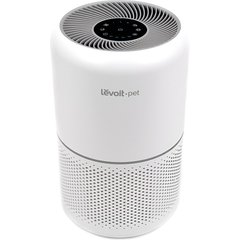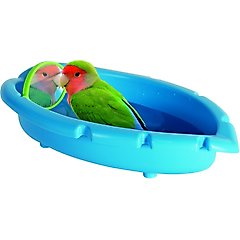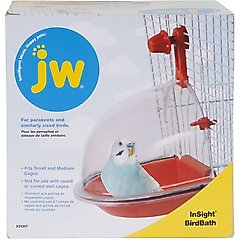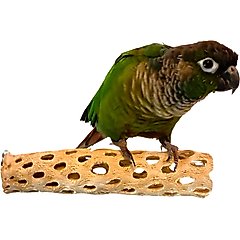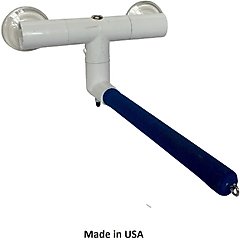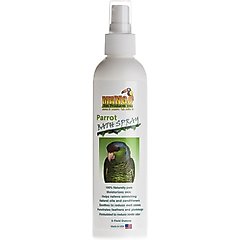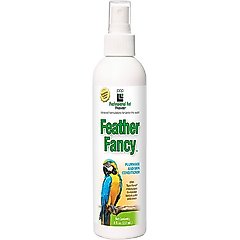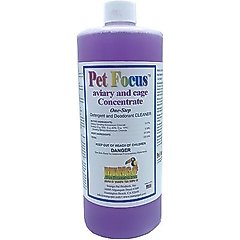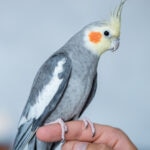What to Know About Bird Bathing: 4 Ways to Bathe Your Pet Bird
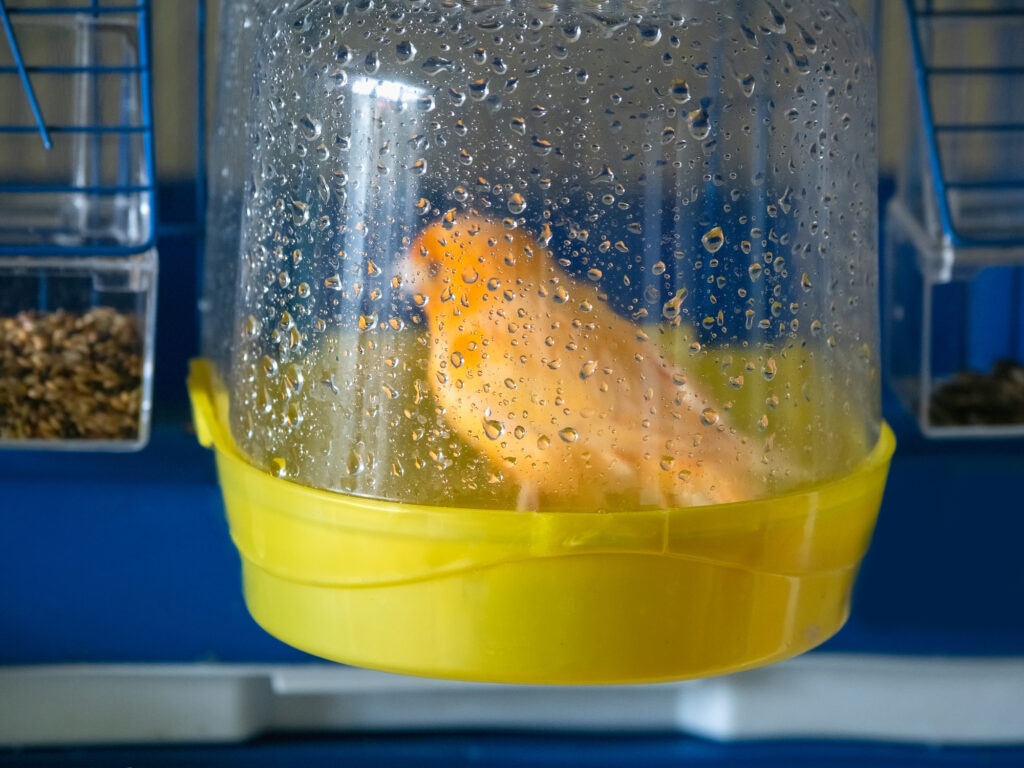
Photo by Stanislav Sablin/iStock/Getty Images Plus
A regular bath, shower, spritz, or slide in plain, fresh water can boost both your pet bird’s mental and physical health. Plus, it’s just fun! But how, exactly, do you give a bird a bath?
All pet birds are individuals, so one parrot might appreciate a bath while another favors a shower. Some birds might not want to bathe at all, and this is perfectly OK. Here’s what to know about bathing your pet bird.
Key Takeaways
- Bathing your pet bird isn’t essential, but a regular bath or misting can help support feather health, control dander, and grow the pet parent-bird bond.
- Every bird has a preference when it comes to bathing. Let them try a few options to see what they enjoy best.
- Pay attention to your bird’s body language when introducing them to a bath or shower. Never force the experience.
- Pet birds should never be towel-dried; instead, let them air-dry naturally.
Do Pet Birds Need To Take a Bath?
No, bathing a bird isn’t 100% necessary, says Larry Nemetz, DVM, of The Bird Clinic in Orange, California, who has been treating birds for over 30 years.
Birds preen, or self-groom. Preening boosts health because the bird spreads out oil from the preen gland, which helps the feathers be more waterproof and lie properly on the body, while also removing dirt.
Even birds who lack a preen gland, like Amazon parrots and some species of macaws, still engage in preening behavior. Because of preening, bathing isn’t necessary.
That said, bird bathing does help birds by:
- Cleaning the surface of their feathers
- Encouraging grooming behavior
- Serving as play time (if they like playing in water)
Bathing your bird can also benefit pet parents, especially those who are allergic to bird dander. Regularly bathing a bird, cleaning the environment every day (plus a weekly deep cleaning), and a using good air filter can reduce bird dander.
Recommended Product
Bird bathing also helps during molting. Molting birds have new feathers emerging that are covered in keratin that a bird scratches or chews off. That keratin releases into the environment, which can impact human allergies, but baths help reduce the amount of keratin that becomes airborne.
If you’re concerned about your bird’s feathers and appearance, a bath might not be the fix. Their diet might actually be the culprit—a poor diet can cause poor feather quality. “I stress diet above all else. Diet is the biggest thing that’s deficient,” says Dr. Nemetz.
Also, knowing signs of a sick bird is very important. Avoid bathing a bird when they’re sick, and seek veterinary care instead.
Do Birds Like Bathing?
Every bird is unique, and that includes their attitude on bathing. Be mindful of your bird’s species and natural behaviors—these can help you know whether they’ll benefit from a bath.
If your home has low humidity and your bird species originated in South America or another tropical area, the chance they’ll welcome a bath increases. On the other hand, desert species (like budgies and cockatiels) might not be as interested.
Some birds might object to bathing altogether. It’s important to watch for any changes in their body language. If they avoid or remove themselves from the water or bathing area, this could be a sign they prefer to keep their feathers dry.
How Often Do Pet Birds Need To Bathe or Shower?
Bathing isn’t necessary at all! But again, some birds like it.
Let your bird guide you. You won’t know whether your parrot wants a bath or shower unless you provide the opportunity to them, and provide that option several times, not just once.
First, offer your bird the opportunity to bathe or shower daily. If your bird wants to bathe every day, give them a bathtub in their cage with fresh clean water, or keep a spray bottle by the cage to shower them yourself.
Just make sure the room isn’t too cold or drafty—this can lead to chilling and make it a challenge for the bird to regulate their temperature.
Another possible reason to give your bird a bath is if they have powder down, specialized feathers in the down that produce keratin from the barbs on the feather. If you see a substance that looks like dust when your bird shakes their feathers, try to bathe them once or twice a week or offer them a bath so they can bathe themselves. The baths keep the dust from filling the air or settling over the area around the bird cage.
Some birds are more hygienic than others and will groom, preen, and want to bathe themselves more often. During your bird’s routine veterinarian visit, make sure to discuss their skin and feathers to ensure your bathing regimen is promoting healthy plumage.
How To Bathe or Shower a Pet Bird
The trick is learning your bird’s preferences. Some species prefer bathing, while some prefer showering or other methods.
Dr. Nemetz says pet birds that typically enjoy baths include:
Cockatoos, Amazons, and cockatiels usually prefer showers.
Keep in mind that all birds are individuals with their own likes and dislikes, so explore your bird’s preferences.
How To Use a Bird Tub
Choose a time when your bird is usually alert, but not too late in the day. Your bird needs time to dry before nightfall. Next, follow these steps:
- In a warm room without drafts, place a shallow bowl, tub (like the Caitec Featherland Paradise Birdie Bath Tub), or other waterproof container on a table. It must be big enough and heavy enough to hold your bird and not tip over. This can also be done in your bird’s cage if there’s enough floor space (and if you don’t mind cleaning the cage afterward). Or, purchase a bird-bathing chamber like the JD Pet InSight Bird Bath to add to the cage.
Recommended Products
2. Pour 1–2 inches of lukewarm water into the container. Do not use soap, shampoo, or commercial bathing solutions with chemicals. If your city adds chlorine to the water supply, use bottled water instead of tap water. Your bird will ingest these materials from their feathers as they preen, and they can be toxic if ingested.
3. Bring your parrot to the water. Depending on their reaction, set them near the container or perched on its edge. The choice to enter the water must be your bird’s; do not force them.
4. Keep a close eye on your bird to ensure they’re enjoying the experience.
5. Move your bird after 20 minutes or so (or sooner, if they appear done). If they bathed, place them on a perch to limit getting their enclosure wet after bathing. If they didn’t bathe, place them in their usual spot for that time of day.
Recommended Product
6. There’s no need to dry your bird after a bath—they handle that themselves with wing flaps and preening.
How To Use Greens for Pet Bird Bathing
This method is best for parakeets, also known as budgies. Introduce them to bird-safe leafy greens if you haven’t already. Only proceed with this leaf-bathing method once your parakeet is used to this treat, so it doesn’t scare them.
Once they’re comfortable with leafy greens:
- Thoroughly wash several leaves of large, leafy greens (good options include Swiss chard, kale, and Romaine lettuce), leaving large drops of water on them. But if your community adds chlorine to the tap water, shake out and dry the leaves.
- Place the greens on a flat, sturdy plate at the bottom of your budgie’s cage. If you had to dry the leaves beforehand due to chlorinated tap water, sprinkle them with bottled water.
- Watch to see if your budgie realizes the leaves can provide a natural bath, like dewdrops or rain on leaves. If your bird doesn’t eat the leaves after bathing, remove them before they spoil.
- Allow your bird to air-dry.
How To Shower a Pet Bird
This method involves placing your bird in your own shower.
- Place a shower perch, like Polly’s Pet Products Shower Perch, on the wall. Shower perches with suction cups are available that adhere to any smooth, flat surface of the shower. You can also place a tall perch stand in the tub or floor of the shower.
Recommended Product
2. Place your parrot on the perch, without the water running, to get them acclimated.
3. When your bird seems comfortable on the perch, turn the water on at very low pressure without getting your bird wet. Use cool or lukewarm water.
4. If your bird is comfortable on the perch with the water on low, increase the water flow. “It is best to use a hand sprayer that can be better controlled versus just a showerhead,” Dr. Nemetz says.
5. After your bird is wet and wants to leave, move them to another perch in a warm, draft-free room to air-dry.
How To Mist Your Pet Bird
Place your bird on a sturdy perch in a warm location where they’re comfortable, and where splashing water isn’t an issue.
- Fill a spray bottle with unchlorinated lukewarm water.
- Gently mist water a foot or so above your bird so the water falls on them from above. Give words of encouragement.
- If your bird is comfortable, stand back a little and spray directly on the wings, back, or torso. Try not to spray your bird in the face or eyes.
- When your bird seems ready for the shower to end, stop spraying. Let them air-dry in a warm, draft-free location.
- Parrot bath sprays are available and can be used in this same way. But talk to your veterinarian before using these sprays, because residue left on feathers will be ingested during preening.
Recommended Products
How To Dry a Pet Bird After Bird Bathing
You don’t need to dry a bird after their bath—birds take care of that themselves through preening.
“Towel drying should NOT be used, as it can easily damage the feather structures,” Dr. Nemetz says. So just place your bird on a favorite perch in a warm, draft-free room and let them do their thing.
Blow-drying can also dry out your bird’s skin and be very stressful, leading them to dislike the bathing experience.
Pet Bird Bathing Safety Tips
Birds show different preferences when it comes to bathing. But whichever method and schedule you stick to, there are certain safety tips to always follow:
- Always go at your bird’s pace; never force your bird out of their comfort zone.
- Use unchlorinated, fresh water.
- Never spray a strong stream of water directly on your bird or place them directly in a strong stream of water.
- Ideally, spray should fall gently on them from above or they should be able to step into (or away from) a bowl of water or a slow trickle from a faucet.
- Never use shampoo or soap, including Dawn dish soap. Use parrot-specific sprays only if approved by your bird’s veterinarian.
- Always regularly clean any bowl, bathing chamber, spray bottle, or other items you use with a bird cage cleaner (such as Pet Focus Cleaner Concentrate) to prevent bacteria contamination.
Recommended Product
- If your pet bird has a foreign substance on their feathers, talk to your veterinarian about removing it.
- Although baths or showers aren’t a necessity for birds, pay attention to preening behavior changes. If your bird preens too much, too little, or suddenly changes their preening routine, call your vet.
Bird Bathing FAQs
Q: Are birds dirty?
A: “No. They’re inherently clean,” says Dr. Nemetz. “They don’t have the same kind of skin as humans. Their feathers [serve as] a protective coating.”
Q: Do birds bathe every day?
A: Birds are individuals, so some might want to bathe or shower daily while others do it more sporadically, if ever. Birds don’t even necessarily need a bath, says Dr. Nemetz. Their preening, or self-grooming, keeps their feathers clean.
Q: Why is my bird taking a bath?
A: Birds take baths or showers for various reasons. Playing in water is fun, it’s bonding time with you during a shower or spray session, and it removes surface dirt.
Q: What time of day do birds bathe?
A: There’s no specific time of day that all birds bathe, as it varies by the bird due to the weather and other factors.
“Mostly it depends on the season,” says Dr. Nemetz. He says some birds sense that rain is coming and want to bathe, some may bathe to cool off if it is a hot afternoon or just to help clean off feathers, and some birds bathe just for fun.
Q: How do I get my pet bird to bathe?
A: You can mimic the sound of rain by turning on a shower or faucet or play rain sounds from your phone. Many birds associate the sound of a running vacuum with rain. If they do this, just mist them with a spray bottle.
Show your bird the bathing bowl or spray bottle mister. Sometimes just seeing these items prompts pet birds to spread their wings. Always go slowly and keep your bird’s comfort level in mind.
Attributions
